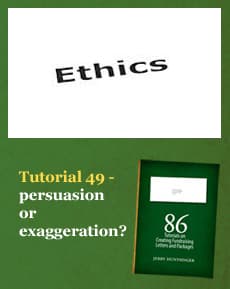Tutorial 49: persuasion or exaggeration?
The writer’s role in ethics: if your letter is not persuasive, then the charity does not reach its financial goal.
- Written by
- Jerry Huntsinger
- Added
- January 11, 2019

But if you cross the line and exaggerate, then you could become the subject of a newspaper expose and, or, the charity watchdogs’ list you amongst those who fail to comply with regulations and need to be watched.
But just what constitutes exaggeration? And doesn’t the consumer patiently go along with the use of superlatives in advertising? Marketing has always been a game of enticing a customer by enhancing the value of a product. And, unhappily, this spills over into direct mail fundraising.
When I’m hired to create a prospect package, I know that unless I come as close as possible to the point of exaggeration, my package probably won’t beat the control. And that is because most controls flirt with exaggeration.
Calm down now. I’m not talking about your control, I’m talking about the other guy’s control. Of course, you wouldn’t exaggerate. Of course, you wouldn’t use a non-existent deadline, or a survey that never is tabulated. And you would never, ever use the word ‘free’ if there are any strings attached.
Just yesterday I received a prospect package from a highly respected national charity and the carrier envelope said, ‘dated material enclosed’. So I looked through the package and there wasn’t any date on the letter and there wasn’t any date on the reply coupon. And apparently I could receive the back-end premium no matter how long I waited to send in my gift. So the teaser copy was, at best, a slight exaggeration and, at worst, a bald-faced lie.
But nonprofits are not alone in this predicament. Also yesterday, I received mail from a bank telling me that ‘your home ownership makes you eligible to receive up to $50,000* giving you the opportunity to consolidate all your debt into one lower payment ...’
Naturally, I looked up the asterisk and it said ‘subject to credit approval. So is it ‘my home ownership’ that makes me eligible to receive the $50,000, or ‘credit approval’? Whoever wrote this promotion must go to bed every night and thank God for asterisks.
And then there is the case of the Manhattan Bagel Company, Inc., who sold their product with the claim, ‘.. we have been named the best bagel in city after city, coast to coast’.
Dunkin Doughnuts challenged the truthfulness of this advertising. Just who named you the best bagel? And what city? Every city? Thousands of cities? The Better Business Bureau got involved and Manhattan Bagel agreed to disclose the circumstances surrounding endorsement of its bagels from city magazines where various authors called Manhattan Bagel ‘the best’.
This reminds me of the obligation some charities feel to establish themselves as ‘the oldest senior citizens group in the country’, or ‘the largest child care organisation in the world’, or ‘the most efficient charity in the country’.
Obviously, if copywriters are ever forced to qualify and clarify every adjective in their letters, we will all be in trouble.
The curse of exaggeration spills over into the nonprofit sector, because, like our cousins who create commercial advertising, we too are human and we too are constrained by economics to attract just as many donors as possible.
But are we required to live by a higher standard? Yes, I think so, because we are closer to the Real Purpose in Life. When you buy a product and consume that product, your act is basically self-centred. You do it because it makes you feel good or makes you happy, or you think you need it. You consume. That’s what drives world economy.
However, when you give, then you are moving toward the spiritual side of life. Sharing is the opposite of consuming. I believe that we live to give and giving is the natural state of things.
But because of our own survival needs, we feel that we must consume in order to stay alive, so a fundraising letter must use certain consumer-oriented techniques in order to attract and hold the attention of that potential donor – but then lead the donor toward a higher experience.
Trust me. The next time you daydream about winning the lottery and imagine yourself as a respected philanthropist, you’ll understand what I mean.
I must confess to you that I intend to keep on flirting with exaggeration and still remain truthful.
Let’s look at key roles the letter-writer can play in helping an organisation shape its ethical guidelines.
In most organisations, the letter-writers do not control the fundamental policies. A writer usually doesn’t decide how much money will be spent on fundraising and how much on programme. A writer doesn’t decide whether or not an organisation will publish a financial statement. A writer doesn’t select the projects that will be promoted.
But here are five things a writer can do:
First, a writer can encourage an organisation to publish a financial statement, because the existence of a financial statement can be an additional reason for a donor to make a gift.
It builds a higher level of confidence. And even though most donors will not request the financial statement, the donor will feel that the organisation has nothing to hide. It is a way of defusing suspicion.
When you inform the prospective donor that a statement is available, you are opening your organisation to public scrutiny. That’s the way it should be.
Second,encourage your organisation to file reports with one or more ‘watch-dog’ agencies. In spite of the obvious frustration involved, the discipline of filing is healthy for an organisation and makes an organisation more responsible to a wider community of the public.
If your organisation cannot meet the standards of at least one ‘watch-dog’ agency – you’ve got problems.
Third, in each appeal, try to explain exactly how the money to be raised will be used and, if possible, even present a detailed budget.
Explain to your boss that many donors need exact figures, especially those in the higher giving ranges.
And please – don’t print hidden disclaimers.
Tell exactly how much money is needed for the project and what you will do with the surplus.
Every fundraiser knows that certain topics raise more money – and the very real temptation is to fund the less attractive projects with the popular ones.
Fourth, attempt to verify the facts before you write the appeal. If possible, visit the project personally. Call a second party on the telephone. Write to someone close to the project. Your goal is not to expose dishonesty, but to be sure the facts are correct.
When a writer can provide a complete and adequate description of the work, the copy is far more persuasive.
Fifth, if you are involved in writing thank-you and acknowledgment letters, you can encourage your organisation to be as objective and accurate as possible in reporting to donors exactly how the charity has used the money that has been raised. This kind of communication with the donor increases the average gift and tends to hold the donor for a longer period of time.
© SOFII Foundation 2010-2014.


 Gwen Chapman is a passionate advocate for donor-centric fundraising. She is a senior consultant with international experience in the non-profit sector in Canada, the United States, the UK and South Africa. She explains the importance to these tutorials
Gwen Chapman is a passionate advocate for donor-centric fundraising. She is a senior consultant with international experience in the non-profit sector in Canada, the United States, the UK and South Africa. She explains the importance to these tutorials 


















